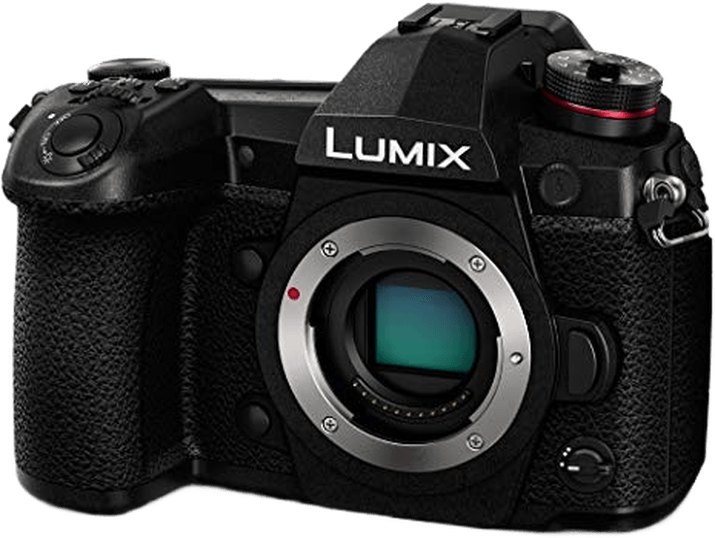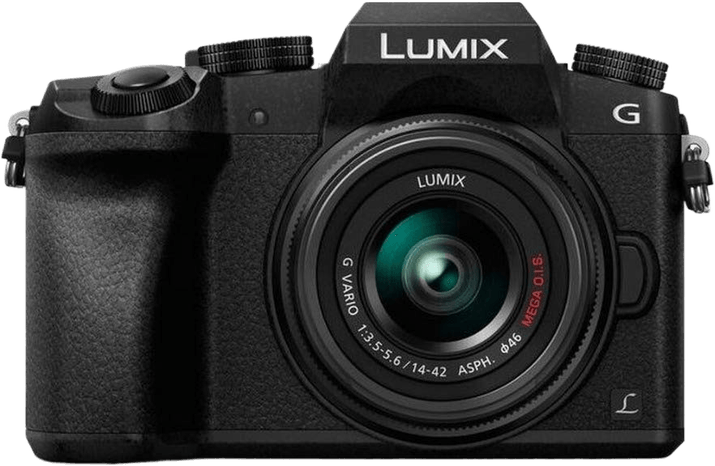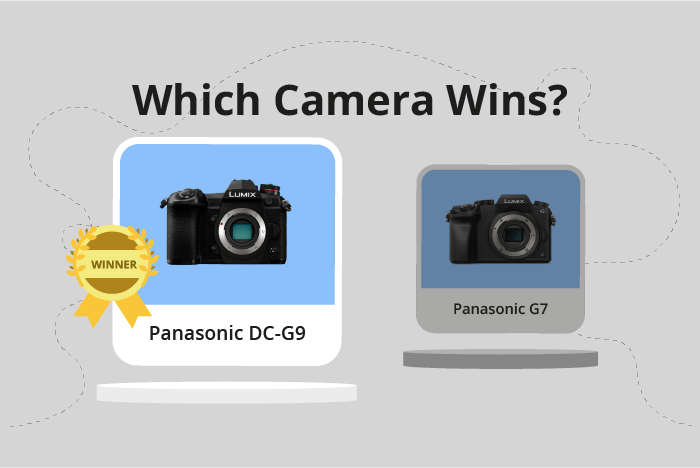Panasonic Lumix DC-G9 vs Lumix DMC-G7 Comparison
Panasonic Lumix DC-G9

Panasonic Lumix DMC-G7

The Panasonic Lumix DC-G9 emerges as the winner with a score of 70/100, and outperforms the Lumix DMC-G7 in several aspects. It boasts a larger size of 137 x 97 x 92mm and a heavier weight of 658g, which might contribute to its durability and sturdiness.
The Lumix DMC-G7 has its advantages as well. It is more compact, with dimensions of 125 x 86 x 77mm, and lighter at 410g, making it easier to carry around. Furthermore, the launch price of $799 makes it a more budget-friendly option for those who are not looking for high-end features.
Taking all these factors into consideration, the Lumix DC-G9 is the superior camera in terms of performance and features, while the Lumix DMC-G7 is a more affordable and portable option for casual photographers.
Panasonic Lumix DC-G9 vs DMC-G7 Overview and Optics
The Panasonic Lumix DC-G9 outperforms the Panasonic Lumix DMC-G7 in optics, scoring 65/100 compared to the G7’s score of 51/100. Both cameras share similarities in specifications, including the sensor type, sensor size, and lens mount.
The G9’s superiority is evident in its higher megapixel count (20 vs. 16), faster shooting speed (20 fps vs. 7 fps), and the inclusion of image stabilization. The Venus Engine processor in the G9 also provides improved image processing capabilities compared to the unspecified processor in the G7. These factors contribute to the G9’s better performance in capturing detailed and sharp images, making it a more suitable choice for professional photography and demanding situations.
On the other hand, the G7 does have a slightly higher DXOMARK score for the sensor (75 vs. 71). This suggests that the G7’s sensor has a marginally better performance in areas such as dynamic range, color depth, and low-light capabilities. However, this advantage is not enough to offset the G9’s overall better performance in other areas.
Taking all factors into account, the Panasonic Lumix DC-G9 is the clear winner in terms of optics. Its higher megapixel count, faster shooting speed, and image stabilization make it the better choice for professional and enthusiast photographers who require top-notch image quality. While the Panasonic Lumix DMC-G7 does have a slightly better sensor performance, it falls short in other areas, making it more suitable for beginners or those on a tighter budget.
Panasonic Lumix DC-G9 vs Lumix DMC-G7 Video Performance
The Panasonic Lumix DC-G9 and the Panasonic Lumix DMC-G7 both have a video score of 83/100. Both cameras share common specifications, including a maximum video resolution of 4K, video dimensions of 3840 x 2160, and a maximum video frame rate of 60fps. Additionally, both cameras have built-in time-lapse.
Users can confidently choose either the Panasonic Lumix DC-G9 or the Panasonic Lumix DMC-G7 based on their individual needs and preferences. Both cameras offer excellent video capabilities, making them suitable choices for a wide range of users.
Panasonic Lumix DC-G9 vs Lumix DMC-G7 Features and Benefits
The Panasonic Lumix DC-G9 outperforms the Panasonic Lumix DMC-G7 with a feature score of 83/100 compared to the G7’s 58/100. Both cameras share some common specifications, such as a 3-inch screen size, touchscreen functionality, flip screen, GPS absence, and WIFI connectivity.
The G9 stands out with a higher screen resolution of 1,040,000 dots, providing a clearer and more detailed display for better image review and menu navigation. Additionally, the G9 has Bluetooth connectivity, allowing for seamless connection with other devices and remote control options.
On the other hand, the G7 excels in screen resolution with 2,360,000 dots, which is more than double the G9’s resolution. This advantage, however, does not outweigh the benefits of the G9’s higher overall feature score.
Overall, the Panasonic Lumix DC-G9 is the better camera in this comparison. Its higher score is a result of its superior features, such as improved screen resolution and Bluetooth connectivity. While the G7 has an advantage in screen resolution, it falls short in other aspects, making the G9 a more versatile and capable camera.
Panasonic Lumix DC-G9 vs Lumix DMC-G7 Storage and Battery
The Panasonic Lumix DC-G9 outperforms the Panasonic Lumix DMC-G7 in storage and battery, scoring 71 out of 100, compared to the G7’s 35 points. Both cameras accept SD, SDHC, and SDXC memory cards and offer USB charging. However, the G9 has a clear advantage with two memory card slots supporting UHS-II compatibility, whereas the G7 has only one slot without UHS-II support.
In terms of battery life, the G9 lasts longer with 400 shots per charge, while the G7 provides 350 shots. The G9 uses the DMW-BTC13 battery type, while the G7 utilizes the DMW-BLC12E battery. Despite the G7’s lower battery life, it still offers decent performance for a camera in its range.
Considering these factors, the G9 stands out as the superior choice for storage and battery capabilities, providing greater flexibility and convenience for photographers. On the other hand, the G7 remains a viable option for those with less demanding storage and battery requirements.
Panasonic Lumix DC-G9 vs Lumix DMC-G7 – Our Verdict
Are you still undecided about which camera is right for you? Have a look at these popular comparisons that feature the Panasonic Lumix DC-G9 or the Panasonic Lumix DMC-G7:

